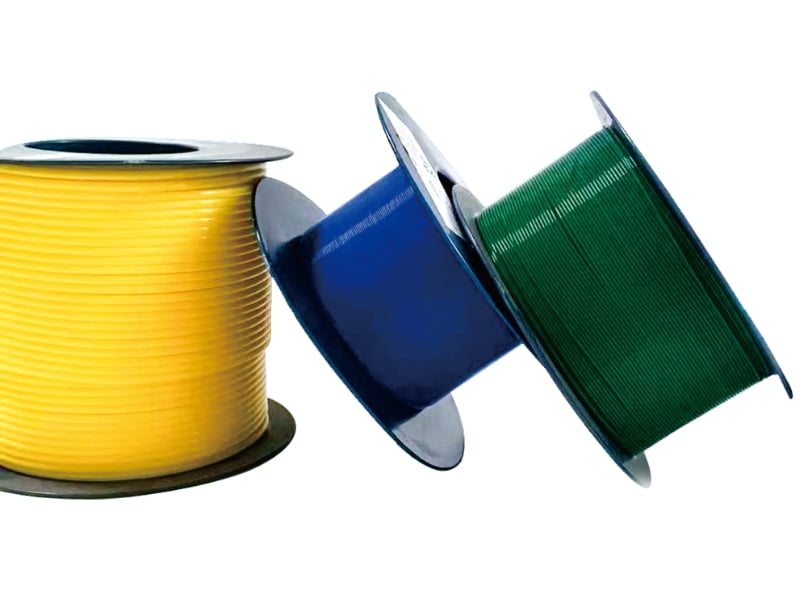Was ist ein PTFE-Schlauch?
Polytetrafluorethylen (PTFE)-Schläuche sind Fluorpolymerschläuche, die für ihre außergewöhnliche chemische Beständigkeit, thermische Stabilität und geringe Reibung bekannt sind. PTFE-Schläuche werden durch Extrusionsverfahren aus hochreinen PTFE-Harzen hergestellt. Das Ergebnis sind halbtransparente bis undurchsichtige weiße Schläuche mit glatter Oberfläche. Die einzigartige Molekularstruktur des Materials, bestehend aus Kohlenstoffatomen, die von Fluoratomen umgeben sind, macht es zu einem der chemisch inertesten Materialien auf dem Markt.

Zu den wichtigsten Eigenschaften von PTFE-Schläuchen gehören:
chemische Beständigkeit: beständig gegen praktisch alle Chemikalien außer geschmolzenen Alkalimetallen und Fluor bei hohen Temperaturen (kompatibel mit >95 % der Industriechemikalien)
Temperaturbereich: -200 °C bis +260 °C (-328 °F bis +500 °F) Dauerbetriebstemperatur
Durchschlagsfestigkeit: 19,7 kV/mm (500 V/mil) bei Standardwandstärke
Reibungskoeffizient: 0,05–0,10 (einer der niedrigsten Werte aller festen Materialien)
Zugfestigkeit: 20–35 MPa (2900–5000 psi), je nach Formulierung
Bruchdehnung: 200-400%
Wasseraufnahme: <0.01% (24h immersion)
surface energy: 18.5 dynes/cm (extremely non-stick)
applications of ptfe tubing
the unique combination of properties makes ptfe tubing suitable for demanding applications across multiple industries:
chemical processing
ptfe tubes serve as liners or transfer lines for aggressive chemicals including concentrated acids (96% sulfuric acid, 37% hydrochloric acid), strong bases (50% sodium hydroxide), and organic solvents (acetone, toluene). their 0% permeability to most chemicals prevents contamination.
semiconductor manufacturing
in cleanroom environments, ultra-high purity ptfe tubing (with <0.1 ppb metallic impurities) transports high-purity chemicals and gases. the material's outgassing rate of <1×10⁻⁹ torr·l/s·cm² makes it ideal for vacuum systems.
medical and pharmaceutical
medical-grade ptfe tubing (usp class vi compliant) is used in catheters, drug delivery systems, and bioprocessing equipment. its non-thrombogenic surface reduces platelet adhesion by 90% compared to other polymers.
automotive and aerospace
ptfe fuel lines withstand ethanol-blended fuels and maintain flexibility at -40°c. in aircraft, ptfe tubing is used in hydraulic systems (withstanding 3000 psi at 200°c).
electrical insulation
ptfe tubing provides volume resistivity >10¹⁸ Ω·cm for high-voltage applications. its dielectric constant of 2.1 remains stable from -40°c to 260°c.
maintenance and care of ptfe tubes
proper maintenance extends ptfe tubing lifespan beyond its typical 10-15 year service life in most applications:
cleaning procedures
for chemical contamination:
immerse in 10% nitric acid solution at 60°c for 30 minutes
rinse with deionized water (18 mΩ·cm resistivity)
dry with nitrogen gas (99.999% purity) at 80°c
for particulate contamination:
ultrasonic clean in isopropyl alcohol (ipa) at 40 khz for 10 minutes
purge with filtered compressed air (0.1 μm filtration)
installation best practices
maintain bend radius >5×od to prevent kinking
use ptfe-compatible fittings (316l stainless steel or peek)
avoid axial loads >50 n during assembly
storage conditions
store at 15-25°c in 40-60% rh
protect from uv exposure (causes <0.1% degradation/year)
keep in original packaging until use to prevent surface contamination
performance monitoring
regularly inspect for:
wall thickness reduction (>10% decrease indicates replacement)
surface cracks (use 10× magnification)
changes in flexibility (test at -20°c for critical applications)



 English
English

